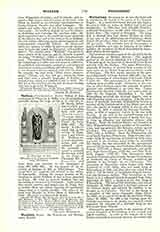

Wounds, THE FIVE SACRED. Devotion.—The revival of religious life and the zealous activity of St. Bernard and St. Francis in the twelfth and thirteenth centuries, together with the enthusiasm of the Crusaders returning from the Holy Land, gave a wonderful impulse to devotion to the Passion of Jesus Christ and particularly to practices in honor of the Wounds in His Sacred Hands, Feet, and Side. The reason for this devotion was well expressed at a later period in the memorial of the Polish bishops to Clement XIII: “Moreover, the Five Wounds of Christ are honored by a Mass and an Office, and on account of these wounds we venerate also the feet, hands, and side of the most loving Redeemer, these parts of Our Lord’s most holy body being held more worthy of a special cult than the others, precisely because they suffered special pains for our salvation, and because they are decorated with these wounds as with an illustrious mark of love. Therefore, with living faith they cannot be looked upon without a special feeling of religion and devotion” (Nilles, “De rat. feat. SS. Cord. Jesu et Marine”, I, 126).
Many beautiful medieval prayers in honor of the Sacred Wounds, including some attributed to St. Clare of Assisi (indulgenced on November 21, 1885), have been preserved. St. Mechtilde and St. Gertrude of Helfta were devoted to the Holy Wounds, the latter saint reciting daily a prayer in honor of the 5466 wounds, which, according to a medieval tradition, were inflicted on Jesus during His Passion. In the fourteenth century it was customary in southern Germany to recite fifteen Pater Nosters each day (which thus amounted to 5475 in the course of a year) in memory of the Sacred Wounds. Corresponding to the Mass “Humiliavit” in the Roman Missal, there was in the medieval Missals a special Mass in honor of Christ’s Wounds, believed to have been composed by St. John the Evangelist and revealed to Boniface II (532). It was known as the Golden Mass, and was indulgenced by Innocent VI (1362) or John XXII (1334); during its celebration five candles were always lighted. It was popularly held that if anyone should say or hear it on five consecutive days he should never suffer the pains of hell fire (Franz, “Messe im Mittelalter”, 159). The Dominican Rosary also helped to promote devotion to the Sacred Wounds, for while the fifty small beads refer to Mary, the five large beads and the corresponding Pater Nosters are intended to honor the Five Wounds of Christ (Beissel, “Verehrung Marias”, I, 525). Again, in some places it was customary to ring a bell at noon on Fridays, to remind the faithful to recite five Paters and Aves in honor of the Holy Wounds. A corona, or rosary, of the Five Wounds was approved by the Holy See on August 11, 1823, and again in 1851. It consists of five divisions, each composed of five Glories in honor of Christ’s Wounds and one Ave in commemoration of the Sorrowful Mother. The blessing of the beads is reserved to the Passionists.
The Feast.—The earliest evidence of a feast in honor of the Wounds of Christ comes from the monastery of Fritzlar, Thuringia, where in the fourteenth century a feast was kept on the Friday after the octave of Corpus Christi. The Office was rhythmical (Dreves, “Anal. hymnica”, XXIV, 20; Grotefend, “Zeitrechnung”, II, 1, 115). In the fifteenth century it had spread to different countries, to Salisbury (England), Huesca and Jaca (Spain), Vienna, and Tours, and was included in the Breviaries of the Carmelites, Franciscans, Dominicans, and other orders (Dreves, op. cit., XXIV, XL, XLII). The Feast of the Five Wounds, celebrated since the Middle Ages at Evora and elsewhere in Portugal on February 6 (at Lisbon on the Friday after Ash-Wednesday), is of historical interest. It commemorates the founding of the Portuguese kingdom in 1139, when, before the battle on the plains of Ourique, Christ appeared to Alfonso Henriquez, promising victory over the Moors and commanding him to insert into the coat of arms of the new kingdom the emblem of the Five Wounds (“Propr. Portugalliae” in Weiss, “Weltgeschichte”, III, 251). This feast is celebrated today in all Portuguese-speaking countries. The Proprium of Venice of 1766, which contains perhaps the earliest series of movable feasts in honor of Christ’s Passion, has the Feast of the Five Wounds on the second Sunday in March; it was granted in 1809 to Leghorn for the Friday after Ash-Wednesday, on which day it is still kept in many dioceses of Tuscany, and elsewhere (Mexico). Since 1831, when the feasts in honor of the Passion were adopted at Rome by the Passionists and the city, this feast was assigned to the Friday after the third Sunday in Lent. The Office is one of those bequeathed to us by the Middle Ages. As this feast is not celebrated in the entire Church, the Office and Mass are placed in the appendix of the Breviary and the Missal.
F. G. HOLWECK

